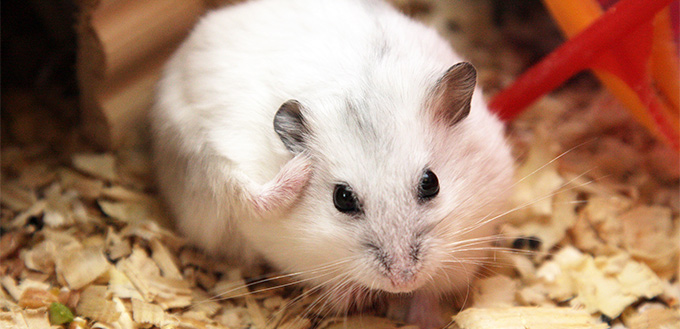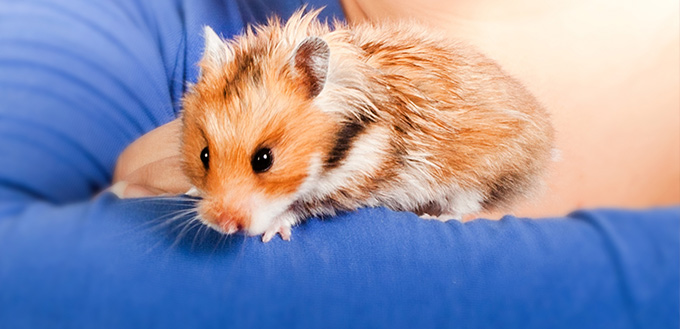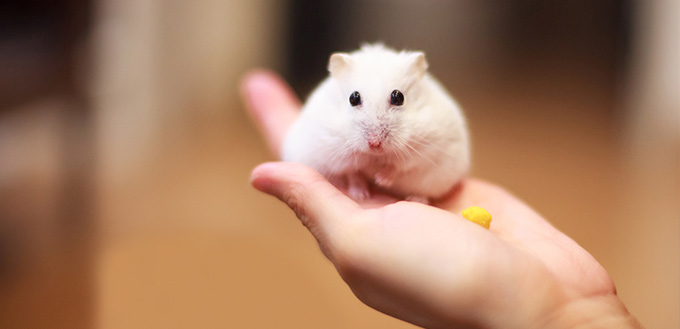Hamsters are great little critters to have around. They’re cute, friendly, and fluffy and they don’t take too much time or energy to care for, especially since they tend to prefer the company of another hamster over us humans. Yet, despite being one of the most common pets in America, most owners aren’t aware that hamsters can actually develop fleas.
Worry not! This is actually quite a common occurrence and getting rid of these little guys is easy as long as you’re consistent and very, very firm. If you’re worried about possible hamster lice or think your hamster has fleas and want to know how to de-flea your hamster, read on and discover everything you need to know.

How Do Hamsters Get Fleas?
While it’s somewhat expected in dogs and cats, especially as they travel outdoors, it seems to be thought of as being very uncommon in rodent families. But, did you know that it only takes one flea to hop on your clothes to create a full-blown infestation in your home?
The reason for this is, as you’re outside, fleas like to hop onto your warm, fluffy clothing which they mistake for fur. They then joyously travel into your home with you – where they happily hop off again- only to make thousands of fleas, and give homeowners a massive headache, if not dealt with promptly?
Since hamsters live in such snuggly, warm conditions due to being nocturnal and enjoying long snoozes in their little burrows, they make for prime real estate when it comes to hamster lice and fleas. The biggest problem, however, is that once they decide on a victim, they tend to breed like… well, fleas.
Since the fleas you see on your pet are only representative of 5-10% of the fleas actually present in the area, it’s safe to say that the best course of defense is offense, when it comes to getting rid of fleas. Add to that, that each female flea can lay up to 2,000 eggs in her lifetime and it soon becomes clear why it’s absolutely imperative that fleas infestations are treated as soon as possible.
The Dangers Of Fleas On Your Hamster
Flea bites are one of the biggest dangers to any animal. It might sound a little dramatic but the range and variety of issues they can cause may surprise you. After all, it was the humble flea that is believed to be the cause of the Black Death, which took up to an estimated 200 million lives in Eurasia during the 1300s. Even now, the Bubonic Plague affects 650 people a year, with a 10% mortality rate. However, in standard cases of smaller flea outbreaks, let’s allow ourselves to be sensible and think a little smaller.
To start, fleas carry a variety of diseases, including the one mentioned above, which can lead to a multitude of problems throughout the home, including yourself. While these illnesses are now much more treatable in this, modern era, there isn’t a great point in curing this, without getting rid of the cause in the first place. So, while you may use antibiotics, for now, you’ll eventually need to get rid of the fleas in order to live peacefully- and with full health.
Naturally, with hamsters being much smaller than ourselves, any issues and infections will affect your rodents on a much more severe scale. Thus, any diseases they may contract are much more likely to be deadly compared to their effect on us. Therefore, it’s always a good idea to take your hamster to a vet as soon as you suspect fleas, in order to ensure a healthy, happy pet.
However, the biggest concern for hamsters suffering from fleas is how quickly they can become anemic. This is due to the amount of blood being taken from them by the hungry fleas and, as I’m sure you can imagine, the longer the fleas are left to breed, the more fleas appear and the quicker your hamster will suffer. This is why you will need to act urgently, should you ever suspect fleas.

Hamster Flea Symptoms
There are a couple of symptoms that you might spot if your hamster gets fleas. However, these can all easily be missed due to their nocturnal sleeping patterns and somewhat shy nature. Therefore, it’s important that you undertake regular health checks, to keep an eye on your hamster. Although you should be giving lots of love and attention to your pet daily, a good health check every week should keep you up-to-speed on how your hamster is behaving and feeling.
The first symptom you’ll probably notice is an increase in scratching. Hamsters are naturally clean animals, so you’ll usually spot them doing some grooming rituals from time to time, however, scratching is usually a different issue. If you spot this, try and do a health check as soon as possible.
Next, you might notice some blistering or small, swollen spots around your hamster’s skin. It’s very likely that there will be a few of these near each other if there is a full flea infestation but usually just one or two should be enough to cause some concern. If you spot these, immediately try to de-flea your pet and clean their cage out, including adding fresh bedding as this is where the fleas are most likely to be nesting, too.
You might then discover some shedding from your hamster, where the scratching has caused them to physically remove fur from their body due to the intense scratching caused by fleas. These patches give you an opportunity to check your hamster’s skin in detail- if you use a torch or bright light along with these patches, you will likely notice tiny dots moving along their skin. These dots are actually tiny fleas crawling over your pet’s body.
Finally, there may be some secondary symptoms from the bites themselves, such as infections. You might also spot your hamster becoming lethargic, or their behavior changing, these are the biggest and most formidable warning signs. Especially as hamsters can easily become anemic through flea bites, which are usually displayed through lethargy.
How To Check Your Hamster For Fleas
We mentioned above one way to check your hamster for fleas, which involves looking over their skin with a torch, if you notice any larger areas of your hamster’s skin, from the extra shedding caused by scratching the itches that fleas cause. However, ideally, these other steps can guide you in checking over your hamster before it gets to that point.
First of all, spend some time with your hamster and check how they’re feeling- you should know their usual patterns and behaviors so it’s usually not too much trouble to spot when they’re behaving differently than normal. Particular behaviors to watch out for include lethargy, sluggishness, lack of appetite and generally lacking interest in life, food, etc.
Next, gently brush your hamster’s fur against the grain (from their rear end to their head). Pay close attention to the lower ends of the fur as you do this. If your hamster has fleas, it’s likely you’ll spot them trying to run back to shelter as the fur parts. This is a guaranteed diagnosis and you should then move on to looking at treatments.
Finally, the most obvious clue left behind by fleas is their droppings. Small block dots will appear all over your poor hamsters fur, as well as around their bedding or in their cage. If you give your hamster fur a gentle brush, you’ll probably notice more appearing as it moves down the length of the fur. Again, at this point, you should move straight on to treating the hamster lice as soon as possible.

Hamster Flea Treatments
There are quite a few options for getting rid of fleas, most of which can be found at reasonable prices and gives you an opportunity to rid your house and your hamster of fleas pretty much immediately.
First and foremost, get yourself a reputable hamster mite spray. These are really easy to use and are perfectly gentle on your hamster’s skin while being deadly for the fleas and lice bothering them. Each type may differ slightly, but the general rule of thumb is to gently brush your hamster’s fur against the grain, so you can see their skin beneath the fur and spray the area just enough to give a slight coat to the skin, then repeat all over the fur until your hamster is a little damp but still relatively happy.
It can be easy to overdo this, so take your time, relax, try not to apply the spray too liberally and, possibly most importantly, be sure to wear some gloves. Most hamsters aren’t going to be too happy about being brushed the wrong way, and being sprayed by something that causes the small insects to go a little crazy might not make them too happy, either.
There are also a number of the usual de-fleaing treatments available at most pet stores. However, before you jump into buying the most potent strength you spot, be sure to have a chat with the sales assistant or with your local vet. There are a few variables here that can affect the abilities of your hamster’s treatment, such as size. For example, a dwarf hamster mite treatment may be different from the standard hamster lice treatment due to the difference in size. Too much flea treatment can actually be detrimental to your pet’s health due to the chemicals used in each pipette, leading to more health problems following treatment.
It’s also really important that the bedding, cage, and even your entire home be treated for fleas as well (depending on how long the fleas have been around, or even just to err on the side of caution). A good idea to get everything done at once is to begin by cleaning out a hamster ball, popping your de-flead hamster inside, and letting them roam around a clean area (tiled is best as there’s nowhere for fleas to nest or hide).
While your hamster is busy exploring their surroundings, empty out the cage completely, throw the bedding and sawdust, etc. in a bag, then throw the bag straight into the bin. Then hoover all the soft furnishings around the area and disinfect the cage. If you really want to be sure your house is completely de-flead, use a flea bomb and vacate the area for a few hours, with your trusty hamster in tow.
Then, simply grab your fresh bedding and sawdust and set about starting a new home for your pet, complete with a completely clean run for them to enjoy. Voila! No more fleas.
Hamster Flea Prevention
As always prevention is better than cure and if you’re looking for ways to avoid flea infestations, you’ve come to the right place. To begin, the best way to avoid fleas is to keep all animals topped up with their flea treatments, to avoid bringing any unwanted guests inside the house. Use the recommended dosage of flea treatments around once a month to keep the pests at bay and this will be a huge factor in avoiding recurrences.
Secondly, be sure to clean your hamster’s cage often, paying particular attention to the bedding and burrows that your hamster makes. It may feel cruel to destroy their hard word but that warm, comfy bedding isn’t just the perfect nesting ground for your hamster- it’s the ideal mating ground for fleas and lice. So, be cruel to be kind and get that bedding changed around once a week.
Finally, as mentioned above, be sure to carry out regular health checks each week. Check their fur as described, and also keep an eye on their teeth and paws- while not necessary to check for fleas, it’s good practice to keep your hamster as healthy and happy as possible. So check those gnashers and claws to spot signs that are irregular and always contact your vet if you’re ever worried about your hamster.
Sources:
- Mite Infestation in Hamsters, PetMD
- Pippa Elliott, MRCVS, How to Rid Your Pet of Fleas, WikiHow






